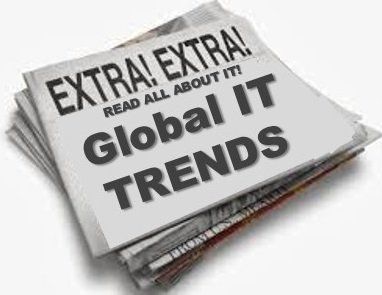
This treatise is for a LinkedIn group of over 2,780 IT leaders representing every IT related profession (CIOs, IT managers & staff, non-IT executives, academia, management consultants, service providers, vendors, and recruiters) from every major geography (North America, Europe, Asia, Latin America, Australia, and Africa).
The 21st Century is marked by the continued penetration of Information Technology (IT) into all facets of the organization. Businesses, regardless of their size, cannot function without IT enabling/driving every activity, from traditional back-office systems to strategic services that interact with customers/clients and external partners. With the global business environment, organizations, and technology continuing to experience dramatic change at an accelerated pace, the role of IT has become increasingly more complex and challenging. Hence, as IT has become mission critical, it is imperative for IT and business leaders to work effectively and efficiently together to ensure that they are leveraging IT across their organization to attain enterprise wide transformation; not just using IT as a digital extension. SMAC (Social, Mobile, Analytics, and Cloud) technologies are transforming industries. The success of the business depends on the success of IT.
Economic uncertainty, tight talent markets, and the rising need for IT versatility have altered the IT hiring landscape. Hiring tech talent now means navigating an uncertain economy, the effects of widespread tech industry layoffs, and candidates who want to work for a company with a mission and workplace culture that align with their values, including diversity, equity, and inclusion.
Organizations need to be more adaptability. Firms that want to innovate and grow while headcounts are in flux are looking to up-skill talent from within, promote their firm’s strengths to prospective candidates, and broaden their pool of potential hires from nontraditional backgrounds.
External hires are increasingly likely to leave after just a couple of years in a new role. Hiring managers should look within, because tech workers promoted internally tend to stick around longer. In the six months it takes to hire, onboard, and get a new employee up to speed, you can train someone into the role. The business keeps a high performer who would have left without the opportunity to advance. Internal training programs provided by GIIM and structured career paths tell employees that you believe in them and will invest in them.
There are several active blogs discussing the role and the future of IT in organizations; many question the need for a CIO or the use of the "IT" name, and some believe that the business-IT gulf is large and getting larger. Without getting into a debate about the title of the person that heads the IT organization (whatever it might be called), it is essential that someone has that leadership and management responsibility; at least for now. Rather than dispute the existence of IT in the future, the important question that should be discussed is what will be the role of IT and the CIO in the future.
Not only is IT not going away, the role of IT within the enterprise is more important than ever. IT is going through a renaissance that requires the role of the CIO and IT organization, as well as how the business and IT organizations collaborate, to transform.
Although we have experienced many of these concepts in the past, there are two major drivers for this change that make it different. The first is that our research is showing that even with the economic downturn, there is a steady increase in the number of organizations around the globe devoting more time to leveraging IT for revenue generating initiatives.
The second, which is likely driving the first, is due to the dramatic simultaneous changes that we are experiencing in SMAC+ technologies (e.g., Social, Mobile, Business Analytics, Cloud, plus Internet of Things, Robotic Process Automation/Cognitive Computing, Bring Your Own Device - Bring Your Own Infrastructure, and the integration of these technologies with existing technologies), as well as the significant non-technical changes (e.g., economy, sourcing considerations, globalization, politics, terrorism, security threats, natural disasters, wars). Each of these taken individually is significant, but taken together is monumental.
It would be remiss not to point out that over the years there have been noteworthy examples (e.g., American Airlines, American Hospital Supplies, Otis Elevator, FedEx/UPS, USAA, Amazon, eBay) of IT being used to enable revenue generating opportunities. The big difference is that today we are seeing IT drive many of these revenue generating initiatives that are the result of leveraging new technology, and it is being done by more and more organizations around the globe. Additionally, the initiatives of today are motivated by customer demand as opposed to business push. The growing role of the CMO (Chief Marketing Officer) and use of emerging technologies like business analytics (in marketing, R&D, HR, legal...) in many organizations are examples of this departure from the past.
IT has evolved from a group supporting back office processes, to enabling front office processes, to driving business innovation. IT is moving from an organization focusing on metrics/SLAs and expenses to analyze itself, to an organization that is delivering demonstrable business cost reduction, to an organization that is providing distinctive revenue increases.
IT has also evolved from having technical initiatives motivated by pure technology or business desires, to being responsive to customer/client desires. These are significant differences from what we have experienced in the past. Organizations can no longer introduce more systems, services, and data for their own sake. Organizations cannot just focus on leveraging IT to streamline their internal business processes. IT-business organizations that do not recognize this transformation and do not focus more on these revenue generating initiatives will be left behind. The following examples of Cloud and business analytics are illustrative of the changing environment.
Although there are fundamental differences in the specific roles that these senior executives (CIOs) have in different large organizations and industries, there are even bigger differences in the role of the CIO in SMEs (small-medium enterprises). For example, while Cloud will have a substantial impact on all organizations, many blogs profess that SME IT organizations will be eliminated as the result of Cloud. However, these discussions often miss an important contribution of Cloud Computing; it enables these SMEs to consider IT initiatives that heretofore were only available to large organizations (initiatives that can help catapult them to the next revenue inflection point; akin to enabling David size enterprises to defeat Goliath size enterprises). In addition, Cloud in concert with Wiki and crowd sourcing enabling technologies (e.g., social, mobile) will bring significant changes to Networked Organization structures that will provide dramatic changes to the concept of outsourcing. While organizations of every size will need to derive a Cloud Strategy that encompasses the integration of Cloud with other emerging technologies, the SME CIO/IT role for those companies that recognize these opportunities will need to change, perhaps more dramatically than the significant changes that are required of CIOs/IT from large organizations.
Overall IT trends are indicating that Cloud and outsourcing are on the rise. This is suggesting to many that CIOs might not remain in the data-center business. The additional outsourcing of non-strategic initiatives is leaving numerous internal IT organizations focusing on the more strategic initiatives driven by SMAC technologies. As these changes continue, enterprises are moving these strategic initiatives directly under the non-IT organizations that are responsible for their benefits. In viewing the above holistically, we can see indications where these enterprises might not require a centralized IT executive. While the debate goes on regarding the future of IT (hence the value of the discussion group) it is clear that the role of IT and CIOs are going through a significant transformation.
IT for all companies has traditionally focused on building reports about events that happened in the past. Big data and business analytics is now shifting the focus of IT. Instead of just looking backward, IT can develop (and the business can leverage) the capabilities for looking forward. To be able to take advantage of these new capabilities, organizations must recognize that the conventional model requiring data in the warehouse to be ‘clean’ and ‘structured’ must change. Organizations have to get comfortable with the idea that data can (and will be) ‘messy’ and ‘unstructured,’ and that they will have to use external data sources (which have typically not been pulled into enterprise data warehouses) in new and innovative ways. Big data must move towards smart data, as we move to the IoT (Internet of Things). Perhaps more than ever before, business and IT organizations must work together as big data drives big decisions.
These fundamental changes in technology and how the business applies technology are driving the future of IT. Naturally not all organizations can respond in the same way; different situations/criteria will enable or inhibit these changes. In general, organizations need to recognize that competitive advantage that is facilitated by IT is clearly on the rise.
Essential to all organizations is the persistent demand to improve the alignment/integration of IT and business; however, with a stronger focus on paying customers/clients. This must take place while recognizing that addressing revenues does not preclude the continuous emphasis on business process improvement and the IT infrastructure and processes; even if outsourced.
Some might suggest that this is a paradox; a set of contradictions that lies at the heart of IT leadership. Be strategic, tactical, AND operational. Leverage emerging technologies, while being weighed down by day-to-day, the past, and sourcing considerations. We are in the midst of a renaissance. We have never experienced this many environmental, business, and technical changes taking place simultaneously; all which must be addressed.
Perhaps a bigger concern, often raised by these blogs, is that the "C" level IT executives (i.e., CIO, CTO, CISO; and the newer CDO and CAO) have still not lived up to the expectations for C level executives - they lack a business acumen; the same is often true for the rest of the IT organization (this does not preclude the need for them to maintain an appropriate balance of technical skills). At the same time we are finding that an even bigger problem is our non-IT executives not understanding what their role needs to be for IT initiatives. All IT organizations (and their business partners and service providers especially as outsourcing continues to increase) will need to raise their game and master the challenge of this innovative transformation.
The worldwide growth in the use of IT to enable and drive organizational opportunities to improve efficiencies and effectiveness/revenues (even during the economic conundrum) suggests that the future of IT is strong. Multiple studies and our global travels and affiliates have found that there is an increasing demand for skilled IT professionals (internal and outsourced/service provider staff, and vendors). However, as indicated above, the dramatic change to the role of IT and CIO is pervasive.
Today geeks are gods. Leaders that are applying SMAC (Social, Mobile, Analytics, and Cloud) technologies are reinventing the ways in which organizations communicate, market, manage, source, read, play, shop, and live. IT organizations, with effective leaders, have a fine opportunity to place themselves at the heart of corporate strategy. The key is people having the appropriate balance of technical, business/management, industry, and interpersonal skills.
These are exciting times for those individuals and organizations that are prepared. GIIM is focused on preparing IT and non-IT organizations to meet the challenges of our dynamic environment.
Let us know what you think.








